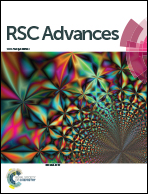PAA/PEDOT:PSS as a multifunctional, water-soluble binder to improve the capacity and stability of lithium–sulfur batteries
Abstract
Lithium–sulfur (Li–S) batteries as lithium secondary batteries have drawn tremendous interest due to their high theoretical specific capacity and energy density. However, the low practical specific capacity and poor cycling life keep them from large scale usage. Herein, a novel binder based on a mixture of polyacrylic acid (PAA) and poly(3,4-ethylenedioxythiophene):poly(styrenesulfonate) (PEDOT:PSS) is designed to significantly improve the specific capacity and cycling stability of Li–S batteries via the synergistic effect of the different functional groups. The conductive PEDOT:PSS successfully facilitates electron transfer and prevents polysulfide dissolution. PAA improves the solvent system for sulfur cathodes and promotes lithium-ion transfer. The sulfur cathode with PAA/PEDOT:PSS binder in a ratio of 2 : 3 exhibits an initial specific capacity of 1121 mA h g−1 and 830 mA h g−1 after 80 cycles at 0.5C. The electrochemical performance of the sulfur cathode with the composite binder is better than either of the single-component binders.


 Please wait while we load your content...
Please wait while we load your content...